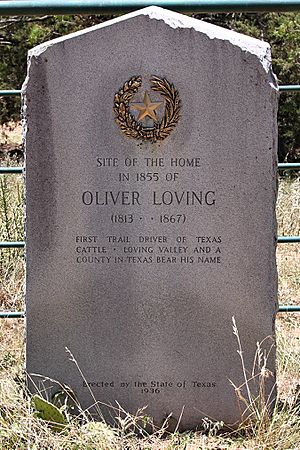Oliver Loving facts for kids
Quick facts for kids
Oliver Loving
|
|
|---|---|
| Born | December 4, 1812 |
| Died | September 25, 1867 (aged 54) |
| Resting place | Greenwood Cemetery in Weatherford, Texas |
| Occupation | Rancher, cattle driver |
| Political party | Democratic |
| Spouse(s) | Susan Doggett Morgan Loving (married 1833-1867, his death) |
| Children | Seven children: Sarah Loving, James C. Loving, William Loving, Sue Loving, Joseph Loving, Annie Loving, Margaret Loving |
Oliver Loving (born December 4, 1812 – died September 25, 1867) was an American rancher and cattle driver. He is famous for helping create the Goodnight-Loving Trail with Charles Goodnight. This trail was a very important route for moving cattle after the American Civil War. Loving was badly hurt by Native Americans during a cattle drive and later died from his injuries.
Loving County, Texas is named in his honor. This county is one of the least populated in the United States.
Contents
Early Life and Family
Oliver Loving was born on December 4, 1812, in Hopkins County, Kentucky. His parents were Joseph Loving and Susannah Mary Bourland. In 1833, he married Susan Doggett Morgan. They had seven children together.
Starting a Career in Texas
Loving began his career as a farmer in Kentucky. In 1843, he moved to the Republic of Texas with his brother and brother-in-law. In Texas, he received large areas of land in Collin, Dallas, and Parker counties. He farmed this land and also hauled goods to support his family.
By 1855, Loving and his family moved to what would become Palo Pinto County, Texas. There, he ran a country store and started a ranch. By 1857, he owned a lot of land and had a large herd of cattle. To sell his cattle, he began driving them out of Texas. That same year, he sent his 19-year-old son, Joseph, to drive cattle to Illinois using the Shawnee Trail. This trip was very successful, and Loving made a good profit. He repeated the trip the next year.
Cattle Drives and the Civil War
In 1860, Oliver Loving and John Dawson started a cattle drive to Denver, Colorado. They planned to sell beef to miners there. They traveled across the Red River and followed the Arkansas River to Pueblo, Colorado. The cattle stayed there for the winter.
In the spring, Loving sold his cattle for gold. He tried to return to Texas, but the American Civil War had begun. Union authorities stopped him from going back to the South. Famous frontiersman Kit Carson helped him eventually return. During the war, Loving was asked to provide beef for the Confederate States Army. He drove cattle along the Mississippi River.
The Goodnight-Loving Trail
After the Civil War, there was a great need for cattle in places like Fort Sumner, New Mexico. About eight thousand Native American Indians lived on a reservation there. In 1866, Loving teamed up with Charles Goodnight. They gathered a herd of cattle and began a long drive to Fort Sumner. Their route later became famous as the Goodnight-Loving Trail.
Loving and Goodnight sold beef to the army for a good price. Then, Loving continued driving some of the cattle to Colorado and sold them near Denver. Goodnight returned to Weatherford with the money to get another herd. The two men met again in New Mexico. They partnered with John Chisum at his ranch. They spent the winter supplying cattle to Fort Sumner and Santa Fe.
A Tragic Last Drive
In the spring of 1867, Loving and Goodnight returned to Texas for another cattle drive. This third drive was difficult due to heavy rains and threats from Native Americans. Loving decided to go ahead of the main herd to arrange contracts for the cattle. He took only his trusted scout, Bill Wilson, with him.
Loving had told Goodnight he would travel at night through Native American territory. However, he pushed ahead during the day. During a Comanche attack, he was seriously wounded at Loving Bend on the Pecos River. Loving, who was very weak, sent Wilson back to the herd. He managed to escape the Native Americans and, with help from Mexican traders, reached Fort Sumner. Sadly, he died there on September 25, 1867, from an infection called gangrene.
Before he died, Oliver Loving asked Charles Goodnight to promise that he would be buried in Texas. Goodnight kept his promise. Loving was first buried temporarily at Fort Sumner. Later, Goodnight had Loving's body dug up and brought back to Texas. Oliver Loving was reburied in Greenwood Cemetery in Weatherford, Texas, on March 4, 1868. He was buried with Masonic honors.
Legacy and Remembrance
Oliver Loving's legacy lives on in several ways. Loving County, Texas is named after him, as is the town of Loving, New Mexico. Also, Loving Bend on the Pecos River carries his name.
He has been honored at the National Cowboy & Western Heritage Museum in Oklahoma City, Oklahoma. His story also inspired parts of the famous novel Lonesome Dove by Larry McMurtry. In the book, a character named Augustus "Gus" McCrae is injured and dies, and his friend Woodrow F. Call brings him back to Texas for burial, much like Goodnight did for Loving. In 1958, Oliver Loving was inducted into the Hall of Great Westerners at the National Cowboy & Western Heritage Museum.
Secondary source
- Madeline Meyercord. Oliver Loving, Pioneer Drover of Texas. 277 pages.


